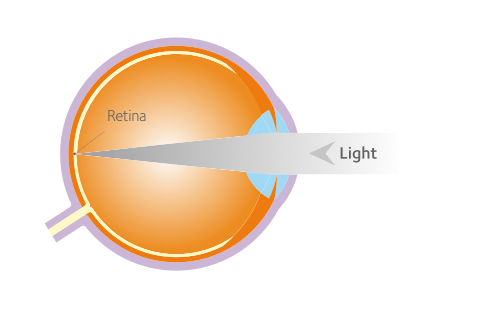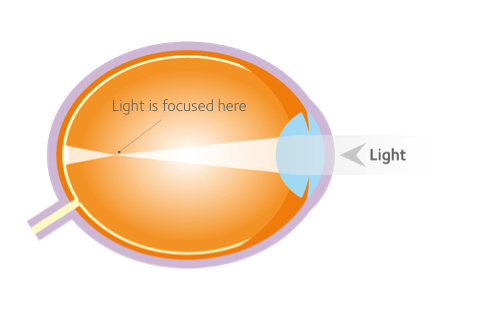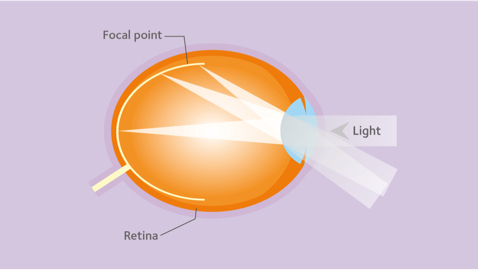Myopia Management vs Myopia Correction
Myopia is traditionally corrected with standard spectacles or contact lenses by using the lenses to focus light rays on the macula to give clear distance vision. Light may also be refracted through standard spectacles or contact lenses creating a scenario which may cause peripheral light rays to focus behind the retina – this phenomenon is sometimes called relative peripheral hyperopic defocus.
Typical Eye
Light focuses on the retina for a clear image.

Myopic Eye
As the eye continues to grow, the myopia progresses and the distance vision becomes more blurry.

Relative peripheral hyperopic defocus theory is thought by some to encourage eyeball growth; a consequence of which is increasing axial length and refractive error. Under-correction of myopia (which reduces the amount of peripheral hyperopic defocus) has been considered as a treatment to reduce myopic progression, but studies have shown that it has not been successful in slowing the speed of myopia progression.1 2 To read more about under-correction and un-correction, click here

Traditional myopia correction:
Relative peripheral hyperopic defocus theory

Optical treatment of myopia:
Relative peripheral myopic defocus theory
Optical Management of Myopia
Optical management of myopia may rely on correcting the existing myopia and deliberately creating relative myopic defocus using the following methods:

Dual focus contact lenses
MiSight® 1 day with ActivControl™ technology is a soft, daily-disposable contact lens specifically designed for myopia control in children. It was the first soft contact lens granted approval with a CE mark specifically for the control of myopia in young myopic children and has been shown to reduce progression on average by around 60% over 3 years.
Ortho-Keratology
Ortho-Keratology (Ortho-K, corneal reshaping technology) lenses are rigid lenses that are designed to be worn overnight. An Ortho-K lens is shaped to gently flatten the cornea to neutralise the prescription to correct myopia so that on waking, the lenses are removed and throughout the day, the child can see without contact lenses or glasses. The flattening of the cornea is currently believed to create a profile that may produce myopic defocus, which is thought to control axial length and therefore slow down the myopic progression.

Multifocal contact lenses
Some soft multifocal contact lenses have been shown by some researchers to achieve between 25% and 72% efficacy in clinical trials for controlling the speed of myopic progression. The ADD power of these multifocal contact lenses is believed to provide myopic defocus, which may help reduce the speed of myopia progression. Centre-distance multifocal contact lenses are widely available in a monthly replacement modality and are not currently approved for myopia control.
Spectacles
Progressive lenses, bifocals and specially designed spectacle lenses for myopia management may deliver a range of efficacy up to about 30%. New technology is constantly evolving in this area.
Book an Appointment
To find out if your child is suitable for myopia control book and appointment to discuss the options with one of our optometrists.
Opening hours:
Monday 09:00-17:00
Tuesday 09:00-17:00
Wednesday 09:00-17:00
Thursday 09:00-17:00
Friday 09:00-17:00
Saturday 09:00-13:00
Sunday CLOSED
Want to get in touch?
Phone: 01435 863232
Email: popleandbroadoptcians@gmail.com
Address: 50 High Street, Heathfield, East Sussex, TN21 8JB
